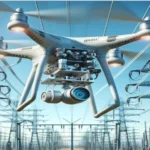The advancement of drone technology has revolutionized modern warfare, and military drones, also known as unmanned aerial vehicles (UAVs), now play a pivotal role in global defense strategies. From surveillance and reconnaissance to targeted strikes, military drones have transformed the battlefield, offering precision, reduced risks, and enhanced situational awareness. This article explores the various aspects of military drones, their applications, and the technological innovations shaping their future.
What Are Military Drones?
Military drones are unmanned aircraft designed for defense and combat purposes. These drones can be remotely controlled or operate autonomously using advanced AI systems. Their primary functions include intelligence gathering, surveillance, target acquisition, and executing strategic strikes.
Key Features of Military Drones:
- Advanced Sensors: Equipped with thermal imaging, night vision, and high-definition cameras for precise data collection.
- Autonomous Navigation: AI-powered systems allow drones to operate without human intervention.
- Stealth Technology: Designed with low radar signatures to evade detection.
- High Payload Capacity: Capable of carrying weapons, sensors, and communication systems.
- Long Flight Durations: Many drones can operate for hours or even days without refueling.
Types of Military Drones
Military drones are categorized based on their size, range, and purpose. Here are some of the most common types:
1. Reconnaissance Drones
- Purpose: Intelligence gathering and surveillance.
- Features: Lightweight, equipped with cameras and sensors.
- Examples: RQ-4 Global Hawk, ScanEagle.
2. Combat Drones (UCAVs)
- Purpose: Engaging targets with precision-guided munitions.
- Features: Armed with missiles and bombs.
- Examples: MQ-9 Reaper, Bayraktar TB2.
3. Decoy Drones
- Purpose: Distracting enemy defenses and mimicking larger aircraft.
- Features: Designed to appear as real threats.
- Examples: MALD (Miniature Air-Launched Decoy).
4. Logistics Drones
- Purpose: Transporting supplies to remote or dangerous areas.
- Features: High payload capacity and long-range capability.
- Examples: Prototypes like the Aerial Delivery Drone.
5. Kamikaze Drones (Loitering Munitions)
- Purpose: One-time use drones that attack targets directly.
- Features: Compact, stealthy, and highly destructive.
- Examples: Harop, Switchblade.
Applications of Military Drones
Military drones have a wide range of applications that make them indispensable in modern warfare. Here are some of their primary uses:
1. Surveillance and Reconnaissance
Drones provide real-time intelligence, monitoring enemy movements, and gathering data on terrains. This allows military forces to plan strategies effectively and reduce risks.
2. Targeted Strikes
Armed drones can neutralize high-value targets with precision-guided munitions, minimizing collateral damage and reducing risks to human pilots.
3. Search and Rescue Missions
Military drones assist in locating survivors in disaster zones or war-torn areas, offering critical aid in rescue operations.
4. Border Patrol and Security
Drones monitor borders for illegal activities such as smuggling and unauthorized crossings, enhancing national security.
5. Electronic Warfare
Advanced drones can jam enemy communications, intercept signals, or disrupt radar systems, giving militaries a strategic advantage.
Advantages of Military Drones
The use of drones in military operations offers numerous benefits, including:
- Reduced Human Risk: Drones minimize the need for human pilots in dangerous missions, reducing casualties.
- Cost-Effectiveness: Operating drones is often more economical than deploying manned aircraft.
- Precision: Advanced targeting systems ensure minimal collateral damage.
- Stealth: Drones can operate undetected in hostile environments.
- Versatility: Capable of performing a wide range of tasks, from surveillance to combat.
Challenges and Ethical Considerations
Despite their advantages, military drones also pose significant challenges and raise ethical concerns:
1. Civilian Casualties
The use of drones in combat has led to unintended civilian casualties, raising questions about accountability.
2. Cybersecurity Risks
Drones are vulnerable to hacking, which could compromise missions or lead to unauthorized use.
3. Autonomous Warfare
The rise of AI-powered drones has sparked debates about the moral implications of machines making life-and-death decisions.
4. Proliferation
The increasing availability of drone technology raises concerns about its misuse by non-state actors or rogue nations.
Innovations in Military Drone Technology
The field of military drones continues to evolve rapidly, with several groundbreaking innovations:
- AI and Machine Learning: Enabling drones to operate autonomously and adapt to dynamic environments.
- Swarm Technology: Coordinating multiple drones to work together for complex missions.
- Solar-Powered Drones: Extending flight durations for long-term surveillance.
- Hypersonic Drones: Enhancing speed and performance for advanced operations.
- Counter-Drone Systems: Developing technologies to detect and neutralize enemy drones.
The Future of Military Drones
As technology advances, military drones are expected to become even more integral to defense strategies. Future developments may include:
- Enhanced AI: More intelligent systems for autonomous decision-making.
- Increased Collaboration: Integration with manned aircraft for coordinated missions.
- Global Regulations: Establishing international guidelines for drone warfare.
- Humanitarian Uses: Expanding the role of drones in disaster relief and peacekeeping efforts.
Conclusion
Military drones have redefined modern warfare, offering unparalleled capabilities and strategic advantages. From surveillance to combat, these high-tech machines have become an essential part of defense operations worldwide. However, their rise also brings challenges and ethical dilemmas that must be addressed as the technology continues to evolve.
As nations invest in developing more advanced and versatile drones, the role of UAVs in military strategy will undoubtedly expand, shaping the future of global security. The journey of military drones is just beginning, and their potential is limitless.




